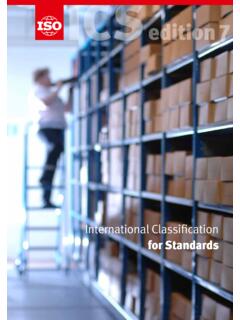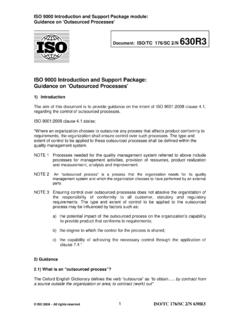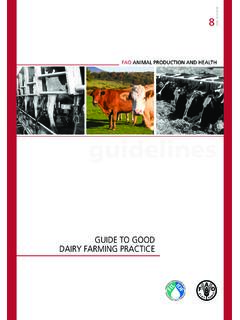Transcription of ISO and Food EN 2018
1 ISO and foodGreat things happen when the world are an independent, non-governmental are a global network of national standards bodies with one member per are not for profit : selling our standards allows us to finance their development in a neutral environment, to maintain them and to make new job is to make International Standards. We are coordinated by a Central Secretariat in Geneva, are ISO, the International Organization for StandardizationISO provides a platform for developing practical tools through common understanding and cooperation with all stakeholders. 21 500* International Standards100new standards each month247* technical committees162* membersNotice that our acronym doesn t match our name ? It s not meant to. ISO is derived from the Greek word isos (equal), so that it s the same in all languages. * April 20174 Why do we need ISO standards for food ?The world population is growing rapidly and many food products repeatedly cross national boundaries to meet our rising demand for food.
2 International Standards help to address this challenge in a safe and sustainable way, through guidance and best practice in food production methods and testing, to promote safety, quality and efficiency across the entire food develops ISO standards ?ISO standards are developed by groups of experts within technical commit-tees (TCs). TCs are made up of representatives from industry, non-governmental organizations, governments and other stakeholders who are put forward by ISO s members. Each TC deals with a different subject, such as food safety or specific food products like tea or meat, often in close collaboration with other relevant international or intergovernmental organizations. For example, the food-related committees work closely with the Codex Alimentarius and the World Organisation for Animal Health (OIE). Visit our Website to find out more about the standards developed in a particular sector by searching for the work of the relevant technical committee.
3 7 All players in the food supply chain, be they farmers, manufacturers or retailers, can benefit from the guidelines and best practice contained in ISO standards, which range from food harvesting to product packaging. In addition, internationally agreed standards help food producers meet legal and regulatory standards address issues relevant to consumers such as food safety, nutritional labelling, hygiene, food additives and more. They give consumers the peace of mind that comes with knowing the food they consume meets high standards for safety and quality and contains what it says on the can rely on best-practice test methods and harmonized terminology that are constantly reviewed and improved, as a technical basis for regulation and benefits from ISO standards for food ?Who benefits from ISO standards for food ?IndustryRegulatorsConsumers8 What standards does ISO have for food ?Of the more than 21 500 International Standards and related documents, ISO has more than 1 600 related to the food sector, with many more in development.
4 These cover :Food productsFood safety managementMicrobiologyFisheries and aquacultureEssential oilsStarch and its by-products9 Below is a selection of ISO technical committees and ISO standards dedicated to food products, food safety, microbiology and related products ISO/TC 34, Food productsMany of ISO s standards related to food are developed by this ISO technical committee. Created in 1947, it is one of ISO s oldest and most prolific committees, with over 830 published standards and 125 more in development. With its numerous subcommittees and working groups, its scope covers everything from food products, such as coffee, meat, milk , spices and cocoa, to vitamins, animal welfare, microbiology and more. ISO/TC 34/SC 5, milk and milk productsWith a portfolio of over 180 standards, this subcommittee plays an important role in the safety, quality and reliability of milk products throughout the dairy chain, from primary production to final consumption.
5 These standards include methods and guidelines for testing and analysing the quantities of components like protein and micronutrients in and milkFollowing the 2008 scandal where infant formula in China was contaminated with melamine, resulting in several deaths and thousands of babies hospitalized, ISO and the International Dairy Federation put together the technical specification ISO/TS 15495, milk , milk products and infant formulae Guidelines for the quantitative determination of melamine and cyanuric acid by LC-MS/MS, an internationally recognized means for regulatory authorities, manufacturers and producers to determine the presence of melamine in ISO 20633, Infant formula and adult nutritionals Determination of vitamin E and vitamin A by normal phase high performance liquid chromatographyThis standard specifies important test methods for the quantitative determination of vitamins and other micronutrients in infant formula, to help ensure that its nutritional content conforms to its declaration.
6 ISO/TC 34/SC 4, Cereals and pulsesForming another key area of standardization, this ISO technical committee has over 60 standards for cereals and pulses covering terminology, sampling, methods of test and analysis, product specifications, and requirements for packaging, storage and transportation. Examples include the four-part series ISO 21415 for the determination of gluten content in wheat and the ISO 6322 series, in three parts, for the safe and hygienic storage of cereals and Food safety management ISO 22000, Food safety management systems Requirements for any organization in the food chain, developed by ISO/TC 34/SC 17, Management systems for food safetyISO has a number of International Standards aimed at ensuring food safety throughout the supply chain. The ISO 22000 family addresses food safety management by providing guidelines and best practice for managing risks in all areas of food 22000 is a certifiable standard that sets out the overall requirements for a food safety management system.
7 It defines the steps an organization must take to demonstrate its ability to control food safety hazards and ensure that food is safe for human consumption. ISO 22000 is one of ISO s best-known standards, with 32 061 certificates issued in 2015 its broad scope, the ISO 22000 family includes standards specific to catering, food manufacturing, farming, packaging, and animal foodstuffs and feed production. Did you know ? ISO 7304 provides guidelines for cooking pasta to perfection. ISO 3103 defines what makes a good cup of tea. ISO 3959 outlines the best conditions for ripening green ISO standards for microbiology are developed by ISO/TC 34/SC 9, of what we eat, including meat, fish and dairy products, contains microbial flora and it is the level of such flora that determines whether it is fit for consumption and how long it will last. ISO has a number of standards for microbiology testing that help to determine safe levels of microorganisms.
8 ISO 16140, Microbiology of the food chain Method validationThis standard was developed to provide a common reference protocol for the validation of alternative methods against a reference method. The two-part series describes the terminology used in microbial testing (Part 1) and gives guidelines for the validation of microbiological test methods (Part 2). These standards are designed to help food and feed testing laboratories, test kit manufacturers, competent authorities, and food and feed business operators implement microbiological test methods. ISO also has numerous standards for the detection of harmful viruses and bacteria in products for human consumption and animal feed. ISO 6579-1, Microbiology of the food chain Horizontal method for the detection, enumeration and serotyping of Salmonella Part 1 : Detection of Salmonella spp. ISO 10272-1, Microbiology of the food and animal feeding stuffs Horizontal method for detection and enumeration of Campylobacter spp.
9 Part 1 : Detection method 1) ISO 11290-1, Microbiology of food and animal feeding stuffs Horizontal method for the detection and enumeration of Listeria monocytogenes Part 1 : Detection method 1) ISO 15216-1, Microbiology of the food chain Horizontal method for determination of hepatitis A virus and norovirus using real-time RT-PCR Part 1 : Method for quantification ISO 16654, Microbiology of food and animal feeding stuffs Horizontal method for the detection of Escherichia coli O157 ISO 19020, Microbiology of the food chain Horizontal method 13for the immunoenzymatic detection of staphylococcal enterotoxins in foodstuffs 2) ISO 22964, Microbiology of the food chain Horizontal method for the detection of Cronobacter , upcoming work in this area comprises standards on whole-genome sequencing for food microbial typing and genomic characterization of foodborne ) Under revision 2) Under development14 Fisheries and aquaculture ISO/TC 234, Fisheries and aquacultureThis ISO technical committee aims to promote sustainable development in the sector and has a number of standards related to traceability and the environmental monitoring of impacts from fish farming.
10 These include the two following standards : ISO 12875,Traceability of finfish products Specification on the information to be recorded in captured finfish distribution chains ISO 12878, Environmental monitoring of the impacts from marine finfish farms on soft bottomEssential oils ISO/TC 54, Essential oilsMore than 130 standards for essential oils are used in food products, perfumes, cosmetics, phytotherapy and and its by-productsStarch is of great importance in the manufacturing of foodstuffs and is used in a wide range of food products, including processed foods, bakery goods, desserts and beverages. ISO/TC 93, Starch (including derivatives and by-products)26 standards are dedicated to starch and its by-products, which cover terminology, methods of analysis, methods of sampling and wine like the expertsWine tasting is an art and, as any wine expert well knows, not any old glass will do. ISO 3591, Sensory analysis Apparatus Wine-tasting glass, defines the best type of glass, as well as its shape and dimensions, to ensure an optimum environment in which the wine can express products Food safety management Starch and its by-productsMicrobiologyEssential oilsFisheries and aquaculture ISO standards improve safety and sustainability in food 34 ISO/TC 34/SC 17 ISO/TC 93 ISO/TC 34/SC 9 ISO standards improve safety and sustainability in food 54 ISO/TC 23418 Feeding our future by going greenWith a growing world population, improving sustainability in the food and agricultural sector is perhaps our only means of survival.













